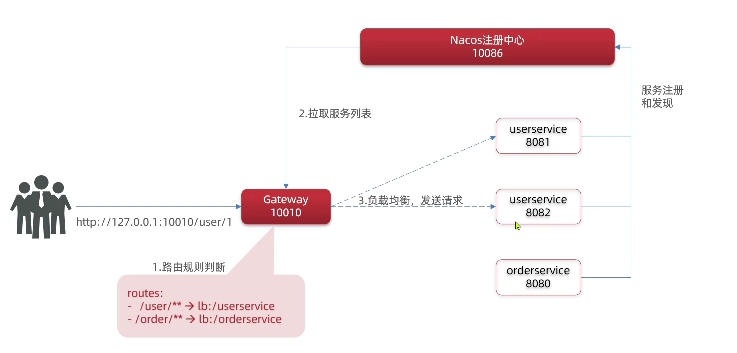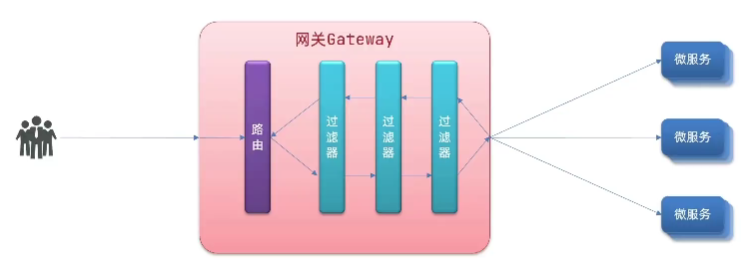When the services in the project are subdivided into many, a unified gateway is needed to control the request and response. In the micro service framework, in order to improve the performance of the gateway, the spring cloud gateway is implemented based on the WebFlux framework, and the bottom layer of the WebFlux framework uses the high-performance Reactor mode communication framework Netty.
The goal of Spring Cloud Gateway is not only to provide a unified routing method, but also to provide the basic functions of the gateway based on the Filter chain, such as security, monitoring / indicators, and current limiting
Gateway service gateway
Gateway functions:
- Identity authentication and authority verification
- Service routing and load balancing
- Request current limiting
Gateway technology implementation:
- Gateway
- zuul
zuul is a servlet based implementation, which belongs to blocking programming, while springcloud Gateway is based on webFlux provided in spring5, which belongs to the implementation of responsive programming and has better performance
Build gateway service
Steps of building gateway
- The key new module introduces Gateway dependency and nacos service discovery dependency
<dependency>
<groupId>com.alibaba.cloud</groupId>
<artifactId>spring-cloud-starter-alibaba-nacos-discovery</artifactId>
</dependency>
<dependency>
<groupId>org.springframework.cloud</groupId>
<artifactId>spring-cloud-starter-gateway</artifactId>
</dependency>
- Routing configuration and nacos registration
spring:
application:
name: gateway # Service name
cloud:
nacos:
server-addr: 127.0.0.1:8848 # nacos service address
gateway:
routes: # Configure routing
- id: user-service # Routing id, user-defined, as long as it is unique
# uri: http://127.0.0.1: destination address of 8082 # route
uri: lb://Target address lb of userservice # route indicates load balancing. / / service name
predicates: # Route assertion is to judge whether the request conforms to the routing rules
- Path=/user/** # Path matching rule, compliant only if it starts with / user
The configurable contents of the gateway include:
- Route id: unique identifier
- uri: routing destination. lb and http are supported
- Predictions: route assertion, which determines whether the request meets the requirements and then forwards it
- Filters: routing filters that process requests or responses
Access the userservice service through the Gateway, 127.0.0.1:10010/user can access the user service
Service gateway structure diagram

Route assertion
- The assertion rules written in the configuration file are just strings, which are read and processed by the Predicate factory and transformed into conditions for routing judgment
- There are more than a dozen assertion factories provided by spring cloud gateway
For example, Path=/user / * * matches by path. This rule is handled by PathRoutePredicateFactory
Basic predicate factory in 11
| name | explain | Example |
|---|---|---|
| After | Request after a certain point in time | - After=2021-09-13T17:32:32.345-07:00(America/Denver) |
| Before | Requests before a certain point in time | - Beforer=2021-09-13T17:32:32.345+07:00(America/Denver) |
| Between | Requests before two points in time | - between=2021-09-13T17:32:32.345+07:00(America/Denver),2021-09-13T17:32:32.345+07:00(America/Denver) |
| Cookie | The request must contain a cookie | - Cookie=XXX |
| Header | The request must contain a header | -Header=token,X-Request |
| Host | The request must be to access a host | - Host=**,www.baidu.com |
| Method | Request mode | - Method=GET,POST |
| Path | Request path rule | -Path=/test/** |
| Query | The request must contain the specified parameters | -Query=name,XXX |
| RemoteAddr | The ip address of the requester must be in the specified range | - RemoteAddr=192.168.1.1/24 |
| Weight | Weight processing |
Detailed usage reference: https://www.cnblogs.com/wgslucky/p/11396579.html
Explanation on the official website: https://docs.spring.io/spring-cloud-gateway/docs/current/reference/html/#gateway-request-predicates-factories
Routing filter
Gateway Filter is a filter provided in the gateway, which can process the requests entering the gateway and the responses returned by the microservice:

Spring provides 31 different routing filter factories, such as:
| name | explain |
|---|---|
| AddRequestHeader | Add a request header to the current request |
| RemoveRequestHeader | Remove request header from request |
| AddResponseHeader | Add a response header to the response |
| RemovResponseHeader | Remove the response header of the response |
| RequestRateLimiter | Limit requested traffic |
| ... | ... |
Explanation on the official website: https://docs.spring.io/spring-cloud-gateway/docs/current/reference/html/#gatewayfilter-factories
Example: add request header to userservice
spring:
application:
name: gateway # Service name
cloud:
nacos:
server-addr: 127.0.0.1:8848 # nacos service address
gateway:
routes: # Configure routing
- id: user-service # Routing id, user-defined, as long as it is unique
# uri: http://127.0.0.1: destination address of 8082 # route
uri: lb://Target address lb of userservice # route indicates load balancing. / / service name
predicates: # Route assertion is to judge whether the request conforms to the routing rules
- Path=/user/** # Path matching rule, compliant only if it starts with / user
filters: # filter
- AddRequestHeader=Message,spring cloud is good # Add request header
- id: order-service
uri: http://127.0.0.1:8082
predicates:
- Path=/order/**
default-filters: # The default filter works for all routes
- AddRequestHeader=Message,spring cloud is good
Test by reading the request header in the controller:
@GetMapping("/{id}")
public UserEntity getUser(@PathVariable String id, @RequestHeader("Message") String message){
// Print out request header information
logger.info("Request header:"+ message);
}
Global filter
The function of GlobalFilter is to process all requests and microservice responses entering the gateway. It is the same as that of GatewayFilter. The difference is that the processing logic of GatewayFilter is fixed through configuration definition, while the logic of GlobalFilter needs to implement its own code
How to define
Implement GlobalFilter interface
/**
* Process the current request,
* @param exchange Request context, which can obtain request, response and other information
* @param chain Used to delegate requests to the next filter
* @return Mono<Void> Returns the end of the current filter business
*/
public interface GlobalFilter {
Mono<Void> filter(ServerWebExchange exchange, GatewayFilterChain chain);
}
Example: define a global interceptor to judge whether the request parameters are compliant
- Whether the parameter has authorization
- Is authorization admin
If satisfied, release; otherwise, write back the response 401
//@Order(-1)
@Component
public class AuthorizationFilter implements GlobalFilter, Ordered {
private static final Logger logger = LoggerFactory.getLogger(AuthorizationFilter.class);
/**
* @description: Verified user
*/
private static final String ADMIN_NAME = "admin";
@Override
public Mono<Void> filter(ServerWebExchange exchange, GatewayFilterChain chain) {
// 1. Get request parameters
ServerHttpRequest request = exchange.getRequest();
MultiValueMap<String, String> queryParams = request.getQueryParams();
// 2. Get parameter value
String authorization = queryParams.getFirst("authorization");
// 3. Judge whether it is admin
if (!ADMIN_NAME.equals(authorization)) {
// 4. If the conditions are not met, write back the response
ServerHttpResponse response = exchange.getResponse();
Map<String, Object> responseData = Maps.newHashMap();
responseData.put("code", 401);
responseData.put("message", "Illegal request");
responseData.put("cause", "user is not admin");
try {
// Convert information to JSON
ObjectMapper objectMapper = new ObjectMapper();
byte[] data = objectMapper.writeValueAsBytes(responseData);
// Output error message to page
DataBuffer buffer = response.bufferFactory().wrap(data);
response.setStatusCode(HttpStatus.UNAUTHORIZED);
response.getHeaders().add("Content-Type", "application/json;charset=UTF-8");
return response.writeWith(Mono.just(buffer));
} catch (Exception e) {
logger.error(e.getMessage(), e);
}
}
// 5. Comply with the rules and let go
return chain.filter(exchange);
}
/**
* @description: Define the filter execution order. The smaller the value, the higher the priority
*/
@Override
public int getOrder() {
return -1;
}
}
Start project, access path http://localhost:10010/user/1 , an error is reported {"code": 401, "cause": "user is not admin", "message": "illegal request"}
Revisit: http://localhost:10010/user/1?authorization=admin, successfully obtained the result {userId ":" 002 "," name ":" Li Si "}
There will be multiple filters in the actual project. How to control their execution order? (refer to the above example code)
-
@Order(XX) adds the annotation on the filter class
XX is a specific value. The smaller the value, the higher the priority
-
Implement the Ordered interface and override getOrder()
/**
* @description: Define the filter execution order. The smaller the value, the higher the priority
*/
@Override
public int getOrder() {
return -1;
}
The above two methods are equivalent. Select one of them to use
Filter execution sequence
Three types of filters will be encountered when requesting to enter the gateway:
- Current routing filter
- DefaultFilter
- GlobalFilter
After requesting a route, the current route filter, DefaultFilter and GlobalFilter will be merged into a filter chain (Collection), and each filter will be executed in turn after sorting

How to merge the three filters if they are not of the same type?
The current routing filter and DefaultFilter are actually GatewayFilter, while GlobalFilter will be converted to GatewayFilter through the GatewayFilterAdapter adapter, and then the three will be combined into a filter chain
summary
- Each filter must set an int order. The smaller the order, the higher the priority
- GlobalFilter can customize the order value by implementing the Ordered interface or the @ order annotation
- The order of the routing filter and the DefaultFilter is specified by spring and is incremented from 1 by default
- When the filter order value is the same, it will be executed in the order of defaultfilter > routing filter > globalfilter
Refer to the source code:
Org.springframework.cloud.gateway.route.routedefinitiongetfilters method in routelocator, first load the defaultFilter, then load the filters of a route, and finally merge
private List<GatewayFilter> getFilters(RouteDefinition routeDefinition) {
List<GatewayFilter> filters = new ArrayList();
if (!this.gatewayProperties.getDefaultFilters().isEmpty()) {
filters.addAll(this.loadGatewayFilters("defaultFilters", new ArrayList(this.gatewayProperties.getDefaultFilters())));
}
if (!routeDefinition.getFilters().isEmpty()) {
filters.addAll(this.loadGatewayFilters(routeDefinition.getId(), new ArrayList(routeDefinition.getFilters())));
}
AnnotationAwareOrderComparator.sort(filters);
return filters;
}
The handle method in org.springframework.cloud.gateway.handler.FilteringWebHandler loads the global filter GlobalFilter, then merges with the previous filters, and sorts according to the order to form a filter chain
public Mono<Void> handle(ServerWebExchange exchange) {
Route route = (Route)exchange.getRequiredAttribute(ServerWebExchangeUtils.GATEWAY_ROUTE_ATTR);
List<GatewayFilter> gatewayFilters = route.getFilters();
List<GatewayFilter> combined = new ArrayList(this.globalFilters);
combined.addAll(gatewayFilters);
AnnotationAwareOrderComparator.sort(combined);
if (logger.isDebugEnabled()) {
logger.debug("Sorted gatewayFilterFactories: " + combined);
}
return (new FilteringWebHandler.DefaultGatewayFilterChain(combined)).filter(exchange);
}
Cross domain
Domain name inconsistency is cross domain, including:
- Different domain names
- Different ports
Cross domain problem: the browser prohibits cross domain ajax requests between the originator and the server, and the requests will be intercepted by the browser
Solution: CORS
The configuration is as follows:
spring:
cloud:
gateway:
globalcors: # Global cross domain processing
add-to-simple-url-handler-mapping: true # Solve the problem that the options request is blocked
cors-configurations:
'[/**]':
allowedOrigins: # Allow those sites to cross domain
- "http://localhost:8090"
- "http://www.baidu.com"
allowedMethods: # Allow cross domain ajax request mode
- "GET"
- "POST"
- "PUT"
allowedHeaders: "*" # Allow cross domain request header information
allowedCredentials: true # Allow cookies
maxAge: 36000 # Validity period of this cross domain detection
Please refer to the official documentation for more configurations